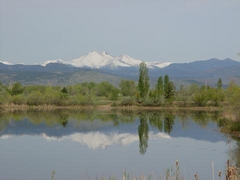Longmont's history of electrification probably starts in the late 1880's when there was a coal-fired plant at Third Avenue and Collyer, operated by Northern Colorado Power Company. Capacity was so tight that citizens who wanted to install an additional light bulb had to come before City Council to get permission. At that time, electricity was only available from 6 AM to 8 PM.
Twenty years later in 1907, Northern Colorado applied for a 25-year renewal of their franchise with the City, but Longmont residents had another idea. The people decided that they could have cheaper and more reliable power if the City provided it. As an example of the sentiment of that time, a front page news story in a March 1911 issue of the Longmont Ledger fortified the issue of a municipality-owned plant, noting that the town of Bellefontaine, Ohio was profitable at owning and operating its own electricity and water plants.
On Tuesday, April 4, 1911, citizens went to vote. On the ballot were two items that would decide the future of electricity in Longmont. Only those who paid a real-estate or personal property tax in 1910, or those subject to such a tax in the future were eligible to vote on these two items:
- Yes/No Authorizing the City to construct a lighting plant. The plant was to be hydroelectric and situated above Lyons with an output of 500 kilowatts.
- Yes/No Authorizing the issuing of bonds to fund the construction of the plant.
- 373 For, 41 Against
- 356 For, 38 Against
A technical description of the City's new plant appeared in a report from the State Engineer to the Governor in 1912:
This is located on North St. Vrain creek in Township 3 North, Range 71 West, 6th Principal Meridian, in Boulder county. The installed capacity is 500 horsepower. There are two Pelton wheels, each thirty-three inches in diameter, rated at 250 horsepower and operating at 600 revolutions per minute. The operating head is 400 feet, and the quantity of water required is eight cubic feet per second. Regulation is by means of a Pelton automatic governor. Each wheel is direct connected to a Ft. Wayne three-phase 250-kiIowatt generator, operating at 2,300 volts. The transmission line is thirteen miles long, and is operated at three-phase and 11,000 volts. The plant is owned by the town of Longmont and the power is consumed for municipal lighting. The plant runs twenty four hours per day. There is no auxiliary steam plant. The plant was built in 1911, and the water supply is thought to be sufficient for ten months in the year.
The final leg of the new electrical system, the actual distribution to houses, was also a problem. Northern Power would not sell their existing outside plant wiring to the City. Again, residents came to the rescue and pledged enough funds to build a new distribution system, with meters.
Meanwhile, Northern Power was not happy with losing Longmont as a franchise and fought back with an injunction in December 1911 that argued against the right of a municipality to have its own power company. Citizens showed solidarity in protesting the Northern Power action by going without electricity and instead using just candles and kerosene lamps. On March 7, 1912 the injunction was ruled in favor of the City and the people took to the streets to celebrate. The City declared itself the "City of Lights" and Council awarded each residence a free un-metered front porch light bulb as a way of lighting the town.
Thirteen years later in 1925, Longmont had 252 front porch lights burning, making it one of the best lighted cities of its size.
And today? The hydro-electric plant from 1912 is still operating at 1195 Apple Valley Road in Lyons. Picture below courtesy of the City of Longmont. The distant driveway entrance to the plant has "DO NOT ENTER" signs so I guess it is off limits although at one time (maybe still?) tours were offered to residents. Local cyclists know Apple Valley Road well, known as one of the "fruit loops", but because the plant is set back from the road a bit, they won't see it when riding along the road.
Almost a hundred years later after that April 1911 election, Longmont has some of the lowest electricity rates in the state. And it's interesting that Boulder is now considering the forming of it's own electric company.
 |
| City of Longmont LPC Harvard Substation |
 |
| Coffman Substation |
Acknowledgement: A lot of the information here comes from a Times-Call guest editorial by Kathy Faatz in the late 1980's.

 One citizen's view of Longmont, Colorado, USA.
One citizen's view of Longmont, Colorado, USA.


wow!!
ReplyDeletethanks!
feels good to be special!!